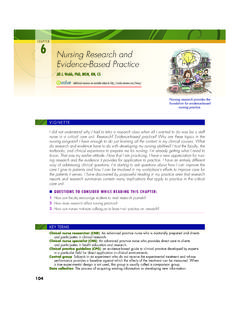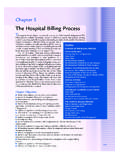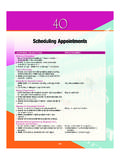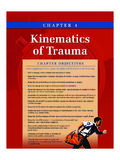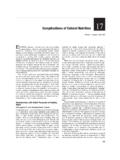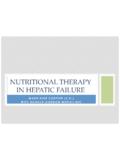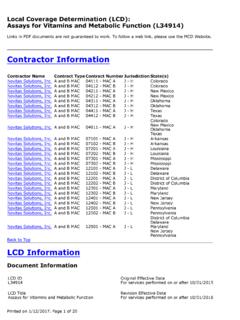Transcription of Nutrition and Metabolic Stress - Coursewareobjects.com
1 Chapter 15 Nutrition and Metabolic Stress 341 One of the fi rst body functions affected by impaired nutritional statue is the immune in WellnessIn its never-ending quest to maintain homeostasis, the human body responds to Stress , physiologic or psychologic, with a chain reaction that involves the central nervous system and hormones that affect the entire body. Magnitude and duration of the Stress determine just how the body will react. It is important for nurses to understand Metabolic changes that take place in reaction to Stress , both in un-complicated Stress that is present when patients are at nutritional risk, and in more multifarious variations that result from severe Stress brought about by trauma or SystemOne of the fi rst body functions affected by impaired nutri-tional status is the immune system.
2 When Metabolic Stress develops, hormonal and Metabolic changes subdue the immune system s ability to protect the body. This activity is further depressed if impaired nutritional status accom-panies the Metabolic Stress . A deadly cycle often develops: impaired immunity leads to increased risk of disease, disease impairs nutritional status, and compromised nutri-tional status further impairs immunity. Recovery requires that this cycle be of NutritionFor the immune system to function optimally, adequate nutrients must be available. A well-nourished body will not be ravaged by infections the way a poorly nourished body.
3 (See the Cultural Considerations box, The Process of Balance, for a multicultural perspective on balanced eating for good health.) To prove this point, think of the leading causes of death in industrialized countries such as the United States. The majority are chronic diseases asso-ciated with lifestyle. In developing countries, however, infections lead to high morbidity and mortality rates, especially in children, largely because of the high rate of protein-energy malnutrition (PEM). The majority of people in the United States who have serious problems with mal- Nutrition and infections are (1) those with severe medical problems, (2) those who suffer from major Metabolic Stress , (3) those who suffer from a diseased state that causes Metabolic Stress and/or decreased nutrient intake and/or nutrient malabsorption, and (4) those who have poor nutritional intakes as a result of socioeconomic conditions ( , poverty, homelessness).
4 Compromised nutritional status creates a vulnerable immune system by making it diffi cult to mount both a Stress response and an immune response when confronted with a Metabolic Stress . A number of nutrients are known to affect immune system functioning. It is diffi cult to deter-mine which specifi c nutrient factor results in symptoms when a patient is malnourished because of overlapping nutrient defi ciencies combined with illness and accom-panied by weakness, anorexia, and Immune system components affected by malnutrition include mucous membrane, skin, gastrointestinal tract, T-lymphocytes, macrophages, granulocytes, and antibodies.
5 CHAPTER 15 Nutrition and Metabolic 3411/10/07 5:42:40 PM1/10/07 5:42:40 PM342 Part 4 Overview of Nutrition TherapyThe effects on the mucous membrane are that the micro-villi become fl at, which reduces nutrient absorption and decreases antibody secretions. Integrity of the skin may be compromised as it loses density and wound healing is slowed. Injury to the gastrointestinal tract because of mal- Nutrition may increase risk of infection-causing bacteria spreading from inside the tract to outside the intestinal system. T-lymphocytes are affected as the distribution of T cells is depressed. The effect on macrophages and granulo-cytes requires that more time be needed for phagocytosis kill time and lymphocyte activation to occur.
6 Antibodies may be less available because of damage to the antibody response. Table 15-1 outlines how specifi c nutrient defi -ciencies affect immune system functions; note that fat and water-soluble vitamins, fatty acids, minerals, and protein are important for adequate functioning of most immune system The Stress ResponseThe body s response to Metabolic Stress depends on the magnitude and duration of the Stress . Stress sets up a chain reaction that involves hormones and the central nervous system that affects the entire body. Whether Stress is un-complicated (altered food intake or activity level) or multi-farious (trauma or disease), Metabolic changes take place throughout the to Gould,2 the body s constant response to minor changes brought about by needs or environment was fi rst noted in 1946 by Hans Selye when he described the fi ght or fl ight response, or general adaptation syn-drome (GAS).
7 The body constantly responds to minor changes to maintain homeostasis. Research following Selye s work has identifi ed that the Stress response involves an integrated series of actions that include the hypo-thalamus and hypophysis, sympathetic nervous system, adrenal medulla, and adrenal Signifi cant effects of this response to Stress are outlined in Table 15-2. These responses to Stress produce multiple changes in Metabolic processes throughout the body. The effect of different levels of Stress on Metabolic rate is illustrated in Figure Process of BalanceWhat is a balanced way of eating for good health? To most Americans, the response is to eat foods from each of the food groups, with particular emphasis on fruits and vegetables.
8 Among other cultures, foods consumed to achieve balance and good health do not follow the American food categories. The Chinese system of yin-yang sorts foods into yin (bean curd or tofu, bean sprouts, bland and boiled foods, broccoli, carrots, duck, milk, potatoes, spinach, and water) and yang (bamboo, beef, broiled meat, chicken, eggs, fried foods, garlic, gingerroot, green peppers, and tomatoes). Foods should be selected from each group to achieve balance. Which foods belong in each group may vary by region, but some foods such as rice and noodles are considered neutral. The overall goal is to maintain the harmony of the body with adjustments for climate variations and physiologic factors.
9 Balance is also the focus of the hot-cold classifi cation of foods practiced in the Middle East, Latin American, India, and the Philippines. This concept is derived from the Greek humoral medicine based on the four natural world characteristics of air-cold, fi re-hot, water-moist, and earth-dry related to the body humors of hot and moist (blood), cold and moist (phlegm), hot and dry (yellow/green bile), and cold and dry (black bile). Although this concept is related to the development of disease and their remedies, it also applies to foods. The hot and cold aspects of specifi c foods are emphasized. This does not relate to the actual temperature of the foods but to their innate characteristics.
10 To achieve balance, eating cold foods offsets hot foods. The list of foods in each category varies among subgroups within each culture. Often, younger generations follow this concept but without knowing that it is based on the hot-cold theory of balance. Application to nursing: Each of the cultures, subscribing to the yin-yang concept and the hot-cold theory, has sizable populations in the United States. When treating Americans of Chinese, Indian, Latino, Middle Eastern, and Filipino descent, these concepts of food selection to achieve health and harmony may affect client food choices. Although healthy selections are often selected, subtle effects may occur.

